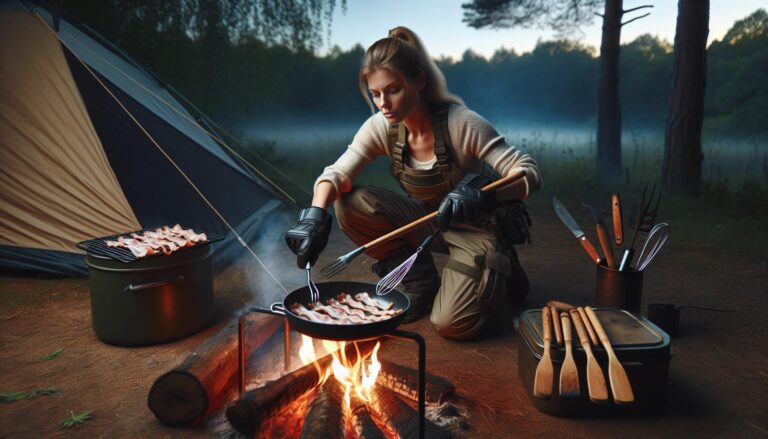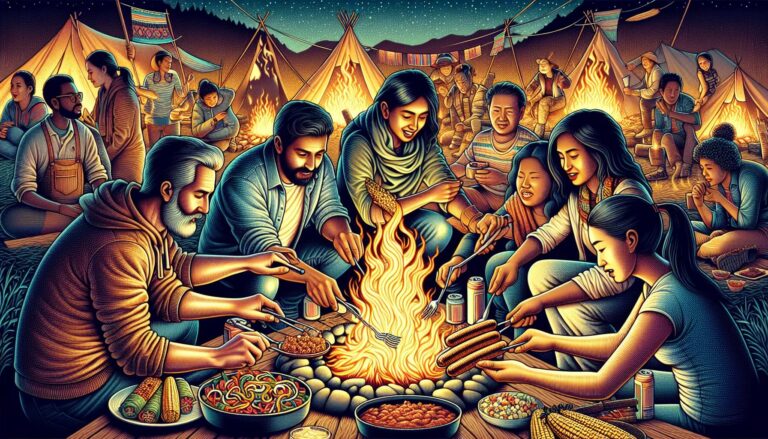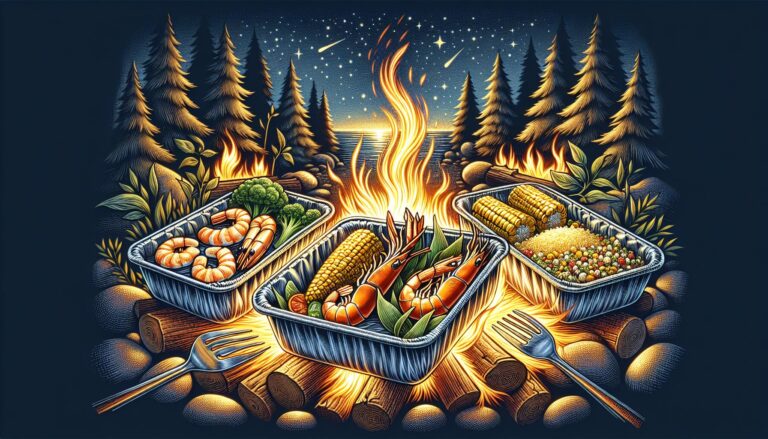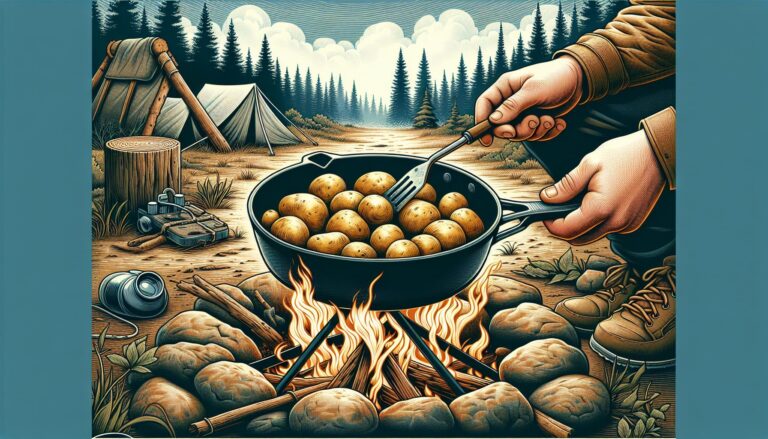Campfire Eggs Mastery: Cook Perfectly on Open Flame
Cooking eggs on a campfire is an art as much as it’s a staple of outdoor adventures. Whether you’re a seasoned camper or a novice to the crackling flames, learning this skill can transform your wilderness meals.
You’ll find that with the right tools and techniques, you can master the perfect campfire egg. From scrambled to sunny side up, your mornings in the great outdoors are about to get a whole lot tastier.
TLDR: Get ready to elevate your campfire cooking game with essential tips for making delicious eggs over an open flame. Perfect for campers at any level, you’ll learn how to cook eggs to perfection amidst nature’s kitchen.
Cooking Equipment
When you’re out in the great outdoors, the right cooking equipment can mean the difference between a mediocre egg dish and a mouthwatering campfire delight. Below, you’ll find essential items and techniques to help you make the best campfire eggs possible.
Choosing the Right Pan
For campfire cooking, cast iron pans are your go-to. They’re durable, retain heat well, and are less prone to hot spots, which means your eggs will cook evenly. When you’re packing for your trip, grab a seasoned cast iron skillet. A non-stick surface is also a bonus when you’re dealing with potentially sticky foods like eggs.
Here are a few tips for pan selection:
- Weight: Cast iron is heavy, so consider pan size based on your need and carrying capacity.
- Handle: Look for a pan with a handle that’s easy to grip with a hot pad or cooking gloves.
- Size: A 10 to 12-inch pan usually offers ample space for cooking multiple eggs.
Using a Cooking Tripod
A cooking tripod can be a game-changer for your campfire egg experience. It allows you to hang your pan above the campfire, giving you adjustable and consistent heat. Adjusting the chain’s length changes the pan’s proximity to the flames, allowing you to control the temperature more precisely.
Setting up your cooking tripod is easy:
- Stabilize the tripod over the campfire.
- Hook your cast iron pan to the chain.
- Alter the height for proper heat distribution.
Alternative Cooking Methods
Not all campfire egg cooking requires a pan. Here are some creative alternatives:
- Egg in an Orange Peel: Halve an orange, remove the fruit, and pour the egg into one of the peels. Place it directly on the coals for a citrus-infused egg.
- Paper Bag Eggs: Coat the inside of a paper bag with oil, crack the eggs into it, and hang it over the fire on a stick. It’s a fun and unique approach.
- Foil Packets: Wrap your eggs and additional ingredients like cheese or vegetables in aluminum foil and place them on the coals.
Each method has its benefits, and experimenting can lead to unexpected and delicious results. Whether you choose the traditional pan approach or opt for a more unconventional method, these options expand the ways you can enjoy eggs on your camping adventure. Keep in mind that whichever method you pick, safety should always remain a top priority to ensure a fun and injury-free cooking experience.
Preparing the Eggs

When you’re ready to dive into the egg-citing process of cooking over a campfire, proper preparation of the eggs is key. This section will guide you through the steps to get your eggs ready to hit the pan—or the peel, bag, or foil—with mouthwatering results.
Cracking and Beating the Eggs
Before you can enjoy your campfire delicacy, you’ll need to crack and beat the eggs. Find a clean, flat surface to crack your eggs against to prevent dirt or debris from joining the mix. It’s best to crack each egg into a separate container before adding it to the main batch – this way, if one’s gone bad, it won’t spoil the others.
After you’ve ensured all your eggs are fresh, pour them into a larger bowl and beat them. You can use a fork, a whisk, or even a clean stick if you’re aiming for a true wilderness experience. Beat the eggs until they find a unity of color and texture, which usually takes about 30 seconds to a minute.
Adding Seasonings and Ingredients
Eggs are a versatile canvas for a wide range of flavors. Adding seasonings and ingredients will elevate your campfire eggs from simple to spectacular. Start with salt and pepper, the basic building blocks of seasoning, before moving on to more complex flavor profiles.
Here’s what you might consider tossing into the mix:
- Chopped herbs like parsley or chives for a fresh kick
- Cheese for a gooey, melty experience
- Diced vegetables such as peppers and onions for crunch and nutrition
- Cubed meats like ham or cooked bacon for a hearty touch
Remember, adding ingredients that require cooking, like raw sausage or bacon, requires them to be cooked prior to mixing into your eggs.
Mixing the Eggs Well
Once you’ve beaten the eggs and added your desired seasonings and ingredients, it’s time to mix everything thoroughly. This ensures each bite is infused with the flavors you’ve chosen. Use your whisk or fork to gently but firmly combine the eggs with the add-ins.
The goal is to achieve a homogenous mixture where the seasonings and ingredients are evenly distributed. A good mix will help prevent the added ingredients from sinking to the bottom or floating on the top once they hit the pan.
As you mix, consider the consistency you’re aiming for. For fluffier eggs, a brisker beating will incorporate more air and result in a lighter texture on your palate. If it’s creaminess you’re after, a more gentle fold will keep the eggs denser and richer.
Now that your eggs are prepped and seasoned to your liking, you’re just a step away from savoring campfire-cooked eggs that’ll have you and your fellow campers asking for seconds.
Cooking Techniques
Frying the Eggs
When you’re in the mood for a classic campfire breakfast, frying eggs is your go-to option. Start by heating up your cast iron pan over the campfire until it’s hot enough that a drop of water sizzles upon contact. Add a small amount of oil or butter to your pan—this is key for preventing your eggs from sticking. Crack your eggs directly into the pan for sunny-side up, or flip them gently for over-easy or over-hard eggs, being careful not to break the yolks. The key is to let the eggs cook slowly; a too-hot pan can lead to burnt whites and runny yolks.
- Heat the pan until water sizzles
- Add oil or butter
- Crack eggs and cook slowly
Keep an eye on the cooking process and adjust the pan’s distance from the flames if necessary. You’re aiming for firm whites and yolks cooked to your preference.
Making Scrambled Eggs
Scrambled eggs are perfect for a filling campfire meal. Before you begin, beat your eggs while they’re still in your mixing bowl, adding a splash of milk for creaminess. Season them with salt and pepper or your choice of herbs and spices. Once your cast iron pan is heated over the campfire, pour in the egg mixture. It’s crucial to constantly stir with a spatula to ensure even cooking and prevent sticking. Cook until the eggs are fluffy and there’s no liquid left. If you’ve added cheese, make sure it’s melted through.
- Beat and season the eggs
- Pour into a heated pan
- Stir constantly until fluffy
Adding extras like diced vegetables or cooked meats transforms your scrambled eggs into a more substantial meal.
Poaching the Eggs
Poaching eggs over a campfire requires a bit more finesse, but it’s definitely worth the effort. You’ll need to fill a pot with water and bring it to a simmer—not a boil—right next to the campfire. Add a splash of vinegar to help the egg whites coagulate faster. Crack your eggs into a small cup or bowl and then gently slide them into the simmering water. Cook the eggs for about three to four minutes for soft yolks or a bit longer for firmer yolks.
- Simmer water with a splash of vinegar
- Slide eggs into water
- Cook for 3-4 minutes
Monitor the eggs closely and remove them with a slotted spoon once they’re cooked to your liking. Poached eggs can be delicate, so handle them with care.
Campfire Safety Tips
Cooking over an open flame is not just about mastering the art of egg preparation—it’s equally important to handle the fire responsibly to ensure your safety and the environment’s. We’ll walk you through crucial safety guidelines to follow when you’re done cooking.
Extinguishing the Fire
After you’ve savored those perfectly cooked campfire eggs, it’s vital that you extinguish your campfire properly. Embers can remain hot long after the flames have died down, posing a risk of reigniting or causing a forest fire. Here’s a simple way to make sure your campfire is completely out:
- Douse the fire with water until all the hissing sounds stop.
- Stir the ashes with a stick or shovel to uncover any remaining hot spots.
- Repeat the dousing and stirring process until everything is cool to the touch.
- Check the area around the campfire to ensure no embers have strayed onto the ground or into nearby brush.
Remember, never leave the campsite unless you’re certain the fire is out and poses no threat.
Cleaning and Packing Up
The Leave No Trace principles are crucial for preserving the natural beauty of the outdoors. When it comes to cleaning up after your campfire cooking session, follow these steps to minimize your impact:
- Collect all food scraps and packaging—wildlife shouldn’t get into human food as it can be harmful to them.
- Dispose of any trash in designated bins or take it with you if none are available.
- Clean your cookware and utensils well away from water sources to avoid contamination.
- Ensure the campfire site is restored and looks as if you were never there, which may include dispersing cooled ashes if allowed in the area.
By adopting these practices, you’ll enjoy your outdoor cooking experiences without detrimental effects on the environment. With your eggs cooked to perfection and the site left pristine, you’re all set for your next campfire culinary adventure.
Conclusion
Mastering the art of cooking eggs on a campfire is a game-changer for your outdoor adventures. With the techniques you’ve learned, you’re now equipped to fry, scramble, and poach eggs to perfection amidst the beauty of nature. Remember to heat your pan just right, keep those eggs moving for the fluffiest scramble, and watch the poaching magic happen with just water and vinegar. Safety and environmental responsibility are your companions on this culinary journey, so always tend to your campfire with care and leave no trace behind. Embrace these practices and you’ll not only craft delicious campfire eggs but also preserve the great outdoors for many breakfasts to come. Happy camping and bon appétit!
Frequently Asked Questions
How do you fry eggs on a campfire?
To fry eggs on a campfire, heat a cast iron pan over the flame, add oil or butter, and cook the eggs slowly until they reach your desired consistency.
What is the best way to scramble eggs over a campfire?
For fluffy scrambled eggs, beat eggs with a splash of milk, add seasoning, and stir them constantly in a heated pan over the campfire until they’re cooked to your liking.
Can you poach eggs on a campfire?
Yes, you can poach eggs on a campfire. Heat water with a bit of vinegar until simmering, then gently slide in the cracked eggs and cook them to your preferred yolk consistency.
What are the essential safety guidelines for cooking over a campfire?
The essential safety guidelines include monitoring the fire at all times, using proper cooking equipment, avoiding loose clothing, and ensuring the fire is completely extinguished after cooking.
Why is it important to follow Leave No Trace principles when cooking on a campfire?
It’s important to follow Leave No Trace principles to minimize environmental impact, preserve natural habitats, and maintain the outdoors for future users to enjoy. This includes cleaning up and disposing of waste properly and respecting wildlife.






